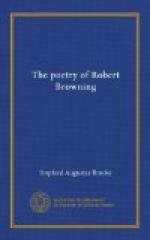We ought not to forget the date of the tale when we read the book. It is just two hundred years ago. The murder of Pompilia took place in 1698; and the book completes his studies of the Renaissance in its decay. If Sordello is worth our careful reading as a study of the thirteenth century in North Italy, this book is as valuable as a record of the society of its date. It is, in truth, a mine of gold; pure crude ore is secreted from man’s life, then moulded into figures of living men and women by the insight and passion of the poet. In it is set down Rome as she was—her customs, opinions, classes of society; her dress, houses, streets, lanes, byeways and squares; her architecture, fountains, statues, courts of law, convents, gardens; her fashion and its drawing-rooms, the various professions and their habits, high life and middle class, tradesmen and beggars, priest, friar, lay-ecclesiastic, cardinal and Pope. Nowhere is this pictorial and individualising part of Browning’s genius more delighted with its work. Every description is written by a lover of humanity, and with joy.
Nor is he less vivid in the mise-en-scene in which he places this multitude of personages. In Half-Rome we mingle with the crowd between Palazzo Fiano and Ruspoli, and pass into the church of Lorenzo in Lucina where the murdered bodies are exposed. The mingled humours of the crowd, the various persons and their characters are combined with and enhanced by the scenery. Then there is the Market Place by the Capucin convent of the Piazza Barberini, with the fountains leaping; then the Reunion at a palace, and the fine fashionable folk among the mirrors and the chandeliers, each with their view of the question; then the Courthouse, with all its paraphernalia, where Guido and Caponsacchi plead; then, the sketches, as new matters turn up, of the obscure streets of Rome, of the country round Arezzo, of Arezzo itself, of the post road from Arezzo to Rome and the country inn near Rome, of the garden house in the suburbs, of the households of the two advocates and their different ways of living; of the Pope in his closet and of Guido in the prison cell; and last, the full description of the streets and the Piazza del Popolo on the day of the execution—all with a hundred vivifying, illuminating, minute details attached to them by this keen-eyed, observant, questing poet who remembered everything he saw, and was able to use each detail where it was most wanted. Memories are good, but good usage of them is the fine power. The mise-en-scene is then excellent, and Browning was always careful to make it right, fitting and enlivening. Nowhere is this better done than in the Introduction where he finds the book on a stall in the Square of San Lorenzo, and describes modern Florence in his walk from the Square past the Strozzi, the Pillar and the Bridge to Casa Guidi on the other side of the Arno opposite the little church of San Felice. During the walk he read the book through, yet saw everything he passed by. The description will show how keen were his eyes, how masterly his execution.




